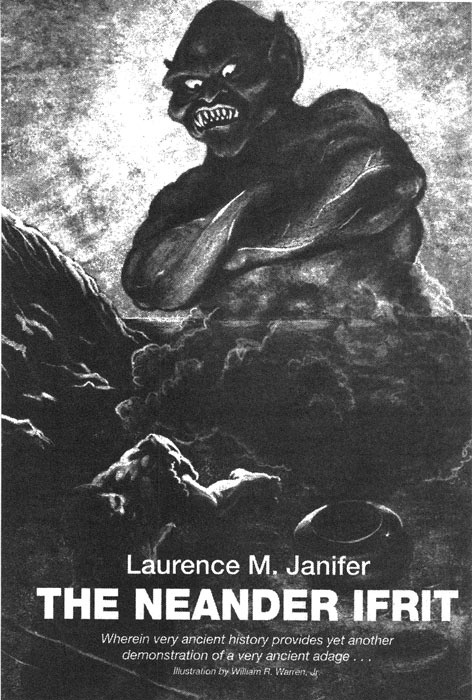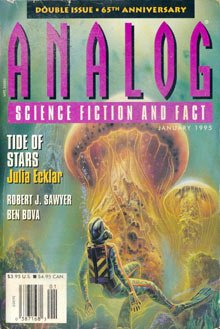Laurence Janifer - The Neander Ifrit
Here you can read online Laurence Janifer - The Neander Ifrit full text of the book (entire story) in english for free. Download pdf and epub, get meaning, cover and reviews about this ebook. year: 1995, publisher: Dell Magazines, genre: Science fiction. Description of the work, (preface) as well as reviews are available. Best literature library LitArk.com created for fans of good reading and offers a wide selection of genres:
Romance novel
Science fiction
Adventure
Detective
Science
History
Home and family
Prose
Art
Politics
Computer
Non-fiction
Religion
Business
Children
Humor
Choose a favorite category and find really read worthwhile books. Enjoy immersion in the world of imagination, feel the emotions of the characters or learn something new for yourself, make an fascinating discovery.
- Book:The Neander Ifrit
- Author:
- Publisher:Dell Magazines
- Genre:
- Year:1995
- Rating:4 / 5
- Favourites:Add to favourites
- Your mark:
- 80
- 1
- 2
- 3
- 4
- 5
The Neander Ifrit: summary, description and annotation
We offer to read an annotation, description, summary or preface (depends on what the author of the book "The Neander Ifrit" wrote himself). If you haven't found the necessary information about the book — write in the comments, we will try to find it.
The Neander Ifrit — read online for free the complete book (whole text) full work
Below is the text of the book, divided by pages. System saving the place of the last page read, allows you to conveniently read the book "The Neander Ifrit" online for free, without having to search again every time where you left off. Put a bookmark, and you can go to the page where you finished reading at any time.
Font size:
Interval:
Bookmark:
The Neander Ifrit
by Laurence M. Janifer

Illustration by William R. Warren, Jr
Dear Stan:
This may be a long sort of letter, so sit back.
New York (to start where everything starts) is a very strange place, and commuters like you never really get to know it. The place has everything, including a pile of stories that are flatly unbelievable; if I told you about Little North Evans Boulevard, for instance, youd accuse me of inventing the whole thing, and there are even people who refuse to believe that there is a spot in Manhattan where Waverly Place crosses Waverly Place and goes charging off in all directions, as the man saidand they can see that one for themselves. All you have to do is find Sixth Avenue (which is easier to do if you remember not to call it Avenue of the Americas) and where it crosses Waverly Place walk west along Waverly, and when you come to the old Infirmary youre there. The sight left a permanent neurosis in an old friend of mine, Im afraid, who happened across it one very drunken night.
And of course the town has a positive farrago of Institutions of Learning, from Columbia and Pace and God knows what-all to, say, the State University of New York (SUNY) and the City University of New York (CUNY), the whole rickety pile of them teaching God knows what to God knows how many eager young minds. Theres one more institution, I findwhose computer is really responsible for this letter, I suppose. Ive just run into the Local University of New York (LUNY).
LUNY is a private universityvery private. They dont want any sort of government funds, being a little afraid that the government would then jump in and tell them what to do, which textbooks to use, and so on; as it is, they may be the only university anywhere that uses Alices Adventures in Wonderland and Through the Looking-Glass as primary math texts, and Gordy Dicksons Dorsai novels as basic sociology. They want no interference, and my guess is that, if government were allowed in, theyd have some.
LUNY has a lot of ties to science-fiction, come to think of it, not the least of which is that the place sounds like science-fiction. Theyve only been open twelve years so far, but some of their early graduates have already found places for themselves in private industry; that plan to bury people in space and sell advertising linage on their coffins, if I have it right, was a LUNY project.
And, as I say, its their computer that is at the root of all this. I ran into it because I was fiddling with an amok-computer story, and ran into a very full professor at an Italian place over here on the Medium West Side (I think New York may have more Italian restaurants than Florence, though I am certainly not going to go there and check), and he talked things over with me the next day in his offices, inside the LUNY Main Building. (By the waytheyre keeping the computer sort of quiet so far, and I hope this letter doesnt injure that privacy anybut what the hell, its just between the two of us, right?)
Part of the computerwhat they call the interactive arrayis named Daisy (because the name occurs in A Bicycle Built for Two, though it is not, damn it, the name of the bicycle), since the computer is built around the idea of two full cycles. That is, every operation goes through two cycles, with a third cycle (which the computer-lab people here have christened the Training Wheels) on call in case of disagreement.
Yes, I know: nearly all computers have an I-tell-you-three-times system, more or less. This is something else. Every operation goes through two such triple plays, and maybe a third, with each individual sheaf of commands checked at interruption points. It slows things down some, though not as much as youd think because some radically new notions are a part of the configuration, but it does, they tell me, give added assurance and added power somehow or other.
The computer as a whole doesnt seem to have a name, and so far has refused to accept one. Whether or not the thing is alive or conscious has been the subject of several ongoing LUNY investigations, and two honors courses, and Ill keep you posted. But it is certainly the damnedest thing of its kind I have ever run across.
It keeps reminding me of a phrase from one of those novels Fred Pohl and Cyril Kornbluth wrote back in the Peculiar Old Daysthe one set in a low-calorie society (which is an exact description) and involving a heroic group called Sons of the Wolf, which I assume was their way of getting Sons of Bitches past what censorship then existed.
This low-calorie society was full of people who meditated, and the prize form of meditation was meditation on connectivity. This made a certain amount of sense in the novel, and it makes much more sense if applied to the LUNY computer, because Connectivity, so to speak, is most of its business.
Its set up to connect every fact its ever been fed with every other fact its ever been fed, which makes for a total number of connections that staggers the mind. Anyhow, it staggers mine, though as I grow older I find I stagger more easily. There did come a point at which the sheer number of discrete connections started the computer losing information (go see a topologist if you dont believe me; what do you think Im doing, making stuff up here?), but by treating the information in ad hoc bunches for purposes of preliminary definable connection they got things back into what they apparently think of as line. And as the LUNY staff has fed the computer every datum a wildly assorted staff could get its hands on (including fictionso labeledmusic, paintings and sculptures as encoded systems, and dictionaries in 170 languages, give or take a dialect) it is making a very great many connections by now.
Their idea is, of course, that material in one area can contribute to work in a whole different areanot exactly a novel notion, but theyre leaning on it a little. I asked my tame professor for an example, and he said that material common to the manufacture of shatterproof glass, the understanding of cattle stampedes, and some oddities involving fractured spines in camels is about to make a breakthrough in that grey area between the quantum-physics world and the Newtonian world in which all of us used to live so happily. Ill write you more about that when I understand it a little better. But the report for the moment starts with all those dictionaries the thing has digested.
It seems (according to the computer) that all known languages do have a few big things in common, though some languages have tried to eradicate these ancient influences. The fact that German has no nonsense words (I mean no deliberate nonsense words), says Daisy, is evidence that German is one such language. Dont ask me, for heavens sake.
I actually talked to Daisy, of coursethe interactive arrayin her office, down in a sub-basement of the Main Building. (Incidentally, everything is in the Main Building, because LUNY only has the one building, though it is a large one; it was named after a Charles Freidrich Main, and if I ever find out who he is or was Ill tell you.) Daisy insists that there are common sub-roots in all languages, that provide a sort of Rosetta Stone not only for written language in general butand very specificallyfor hieroglyphic writing and picture-writing in particular.
In fact, Daisy says, she has examined all the seven-hundred-odd cave paintings available for remote examination, and she claims that they are a form of language, a neat oxymoron: a written prehistory.
There are (Daisy says) five possible positions for each leg, including invisible or not drawn, six possible positions for the head, and so on, and combinations allow for a great many basic roots for words or even, in a way, sentences. Most of the possible positions do turn up in what are labeled later on, as a couple of positions began to be used as shorthand for longer but very common expressions.
Font size:
Interval:
Bookmark:
Similar books «The Neander Ifrit»
Look at similar books to The Neander Ifrit. We have selected literature similar in name and meaning in the hope of providing readers with more options to find new, interesting, not yet read works.
Discussion, reviews of the book The Neander Ifrit and just readers' own opinions. Leave your comments, write what you think about the work, its meaning or the main characters. Specify what exactly you liked and what you didn't like, and why you think so.










